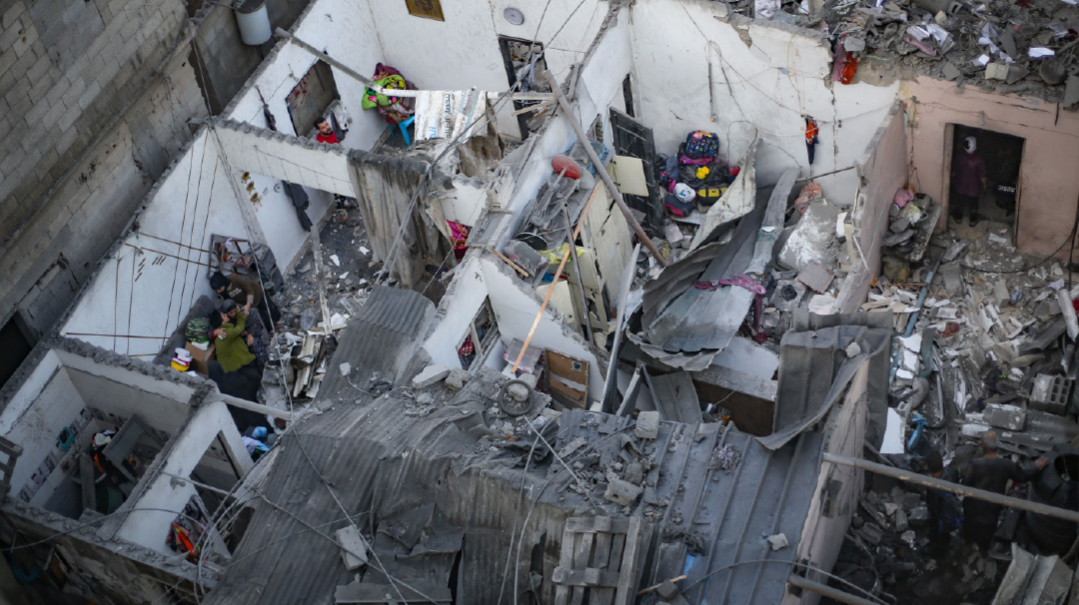An Intractable Dilemma

A failure to destroy Hamas substantially increases the chances of a full-scale war with Hezbollah

ON
October 7, Prime Minister Binyamin Netanyahu declared that Israel would destroy Hamas, in response to the murderous rampage it had unleashed that day.
That declaration drew almost universal support, as the overwhelming majority of Israelis concluded that we can no longer live with a Hamas-governed enclave on our border. That conclusion was made easier by Hamas’s openly expressed intention to attack Israel again and again, just as it had on October 7.
Absent the destruction of Hamas, it is doubtful that all or most of the residents of the Gaza Envelope will return to their homes. And that understandable refusal would, in effect, constitute ceding land to Hamas. In short, a Hamas victory.
No less important, the failure to destroy Hamas, or, at a minimum, expel it from Gaza, would represent a significant diminution in Israel’s deterrence against other enemies, many of them far greater threats than Hamas. At the top of that list is Hezbollah on our northern border, which has up to 150,000 missiles trained on Israel, a significant number of them precision-guided missiles. Hezbollah is also a trained army, hardened by years of military experience on behalf of the Assad regime in Syria.
The bottom line, then, is that a failure to destroy Hamas substantially increases the chances of a full-scale war with Hezbollah — a war that would almost certainly result in casualties, both civilian and military, many multiples greater than those incurred on October 7 or in the subsequent fighting in Gaza.
Moreover, any loss of awe at the capabilities of the IDF reduces the attractiveness of Israel as an ally to the anti-Iran Sunni bloc headed by Saudi Arabia. And in the absence of such an alliance, the Iran-led Shiite bloc becomes the dominant power in the Middle East — which, incidentally, was the goal of the Obama administration’s pro-Iranian policy, a policy that has been continued by the Biden administration.
HAMAS LEADER YAHYA SINWAR holds two powerful trump cards in his efforts to survive and to keep Hamas in control of Gaza. The first, of course, is civilian casualties, which have always been Hamas’s stock in trade. Only a US veto last Friday stood in the way of a UN Security Council resolution for an immediate cease-fire as a response to a humanitarian crisis in Gaza. As Deputy Ambassador Robert Wood put it in explaining the veto, the US opposes a cease-fire that only plants the seeds of the next war.
And that is surely right, as far as it goes. A cease-fire advantages only one party: Hamas. It would soon become permanent, or at least until Hamas initiates the next round of hostilities. But it does nothing to protect Gazan civilians in the long run. Rather it would reinforce the Hamas strategy of embedding its military within civilian areas. In addition, Hamas would continue to divert aid for rebuilding Gaza to its own military uses, while doing nothing to advance the well-being of the civilian population.
Yet continued American support for Israel is far from assured. Both Secretary of State Anthony Blinken and Vice President Kamala Harris issued public statements last week that there have been far too many civilian casualties in Gaza.
In addition, Secretary of Defense Lloyd Austin warned that Israel risks alienating the Gazan civilian population, and creating new enemies in doing so. That latter warning does not even meet the laugh test. All public opinion polling in Gaza shows support at 80 percent or above for the October 7 attacks, and that of Palestinians in the West Bank is as high or higher.
To the extent that there are some Gaza residents who may finally be reconsidering their support for Hamas, that is a function of their recognition of the destruction that it has brought upon them. It has finally dawned on some of them that no Gaza resident ever went to sleep at night worried about an Israeli attack, except in response to a previous barrage of rockets from Hamas and Islamic Jihad aimed at Israeli civilians.
In part, those statements quoted above by senior Biden administration officials are for domestic political consumption — i.e., part of an effort to retain Muslim support for the Democratic Party in key battleground states, as well as to placate the progressive wing of the party.
But they also reflect a certain incoherence in American policy. From President Biden on down, the current administration has supported Israel in its declared goal of completely uprooting Hamas from Gaza. And given Hamas’s use of the civilian population as shields, doing so was guaranteed from the outset to result in many civilian casualties.
“Too many civilians have died” is simply not an argument. For one thing, we have no credible figures on the number of civilian casualties, or how they compare to the numbers of Hamas fighters eliminated. Without concrete suggestions about how Israel could achieve its strategic goals, while greatly reducing the number of civilian casualties and without imposing intolerable casualties on IDF soldiers, “too many” is a meaningless term — at least as something more than an emotional expression of the tragedy inherent in all warfare.
State Department spokesman Matthew Miller has elucidated all the various ways in which Israel seeks to reduce civilian casualties to a degree without parallel among armies anywhere in the world engaged in asymmetric warfare.
Moreover, the widely reported demands from the Biden administration that Israel wind up operations in Gaza by the end of the year cannot be reconciled with its expressed desire to reduce civilian casualties. The slower and more methodical any military campaign, the easier it is to avoid civilian casualties. It took the US and its allies eleven months to rid the city of Mosul in Iraq of ISIS, and even then, over 10,000 civilians were killed. And ISIS had far fewer fighters in Mosul than Hamas has in Gaza, and was far less entrenched than Hamas is in Gaza, which it has ruled since 2007.
SINWAR’S FIRST HOPE FOR SURVIVAL, then, is that the US will force Israel to halt its Gaza campaign by refusing to resupply the IDF with crucial weapons, in the name of “too many civilian deaths.” American pressure in the form of withholding crucially needed military armaments from Israel has been employed many times in the past. In 1970, Prime Minister Golda Meir was forced to accept the Rogers plan to end the War of Attrition along the Suez Canal, and, as recently as 2014, the Obama administration cut off the resupply of Hellfire missiles to Israel in the midst of fighting in Gaza.
But Sinwar also has another trump card to play against Israel in the form of internal pressure to bring the hostages home. As Sinwar has good cause to know, the hostages are, in the words of Professor Yedidya Stern of the Jewish People Policy Institute, Israel’s Achilles heel. Sinwar was only able to mastermind the October 7 atrocities because he was one of the more than 1,000 prisoners returned by Israel in exchange for captured Israeli soldier Gilad Shalit in 2011.
Historian and former Israeli ambassador to the United States Michael Oren recently compared the choice Israel faces between securing the return of hostages and completely defeating Hamas to Sophie’s choice, in a 1979 William Styron novel of that name, about a Polish Catholic forced by the Nazis to choose which of her children to save in Auschwitz.
Israel has always made two commitments to its citizens, writes Oren: “To guarantee our fundamental security and sanctify our citizens’ lives [by] promising that those whom we send off to defend it will never be left behind.” But now, it appears, that Israel cannot simultaneously make good on both promises: “Either we give priority to our deterrence power and returning more than 200,000 displaced Israelis to their homes, or we focus primarily on securing the hostages’ freedom. Either we convince Iran and its proxies never to attack us again and persuade additional Arab countries to make peace with an indomitable Jewish state, or we fulfill Israel’s oath never to abandon our fellow Israelis.”
Even within the Oren home, the argument rages. “Forget the military victory,” his daughter exclaims, “if the state won’t do everything to rescue my children should they someday fall prisoner, how can I send them to the army?”
“Without an Israel, you won’t have an army to send them to,” replies his son.
To date, the choice has not had to be made. It was precisely Israel’s forceful military response in northern Gaza that forced Hamas to offer a hostage-for-prisoner exchange, in return for a temporary pause in fighting.
And so far, there has been no indication that the pause in fighting hurt the IDF’s military effectiveness when fighting resumed in southern Gaza, though many criticized Israel’s commitment to suspend aerial surveillance during the pause.
The tension, however, appears likely to come to a head. Just as the Shalit family did, the families of the current hostages have organized large demonstrations to pressure the government to do more to secure their loved ones’ release. No one can blame them for that. One cannot expect them to rise to the level of the Maharam of Rothenburg, who refused all attempts over the course of seven years to ransom him from the emperor Rudolph, and he ultimately died in prison, on the grounds that ransoming him would only encourage further kidnappings of prominent rabbis to extract exorbitant ransoms.
But as Douglas Murray, Israel’s most forceful advocate in the foreign media, points out, there is an inherent tension between the government’s commitment to eliminate Sinwar and negotiating with him over hostages. And Sinwar, as long as he lives, will never agree to release all the hostages without firm guarantees from the international community that all fighting end with Hamas still in power — something the Israeli government cannot agree to without violating its declared goals on October 7.
Thus, the best hope of securing the release of additional hostages is continued military pressure, followed by the elimination of Hamas, or at minimum the departure of Hamas’s leadership for foreign shores, as Yasser Arafat left Lebanon for Tunis in 1982.
(Originally featured in Mishpacha, Issue 990. Yonoson Rosenblum may be contacted directly at rosenblum@mishpacha.com)
Oops! We could not locate your form.







